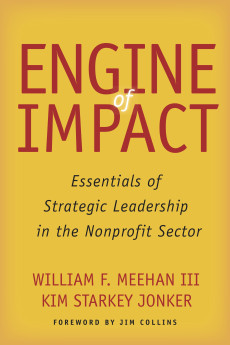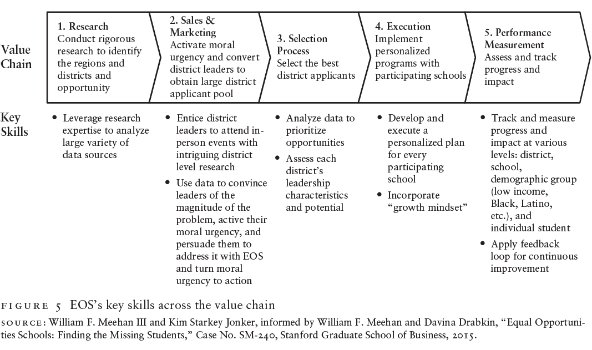
Engine of Impact: Essentials of Strategic Leadership in the Nonprofit Sector
William F. Meehan III & Kim Starkey Jonker
280 pages, Stanford University Press, 2017
In our book, we argue that high-performing nonprofit organizations stand apart from their peers by building an “engine of impact”—a mechanism for moving forward that incorporates seven essential elements. Some of these elements cover areas in which any nonprofit leader will strive to excel: mission, fundraising, board governance. Other elements involve areas that have become increasingly central to nonprofit performance in recent years: impact evaluation, talent and organization, insight and courage. The seventh element, strategy, is absolutely indispensable, yet it can also seem abstract and intimidating. Our goal in writing about this element was to demystify the topic of business strategy for those who don’t have an MBA but who understand that strategic agility is crucial to their work. We titled our chapter on this element “The Few Strategic Principles That Matter,” and that phrase sums up its value proposition.
We developed our engine-of-impact model by closely observing nonprofits that have mastered the essentials of strategic leadership—organizations like Equal Opportunity Schools (EOS). In this excerpt, we discuss the strategic principle of “core competencies” and then describe how EOS has rigorously applied that principle across its value chain.—William F. Meehan III and Kim Starkey Jonker
We define a nonprofit’s strategy as a planned set of actions that are designed to achieve its mission. By contrast, the strategy of a for-profit business is a planned set of actions that aim to maximize shareholder value by achieving sustainable competitive advantage. Fortunately, academics and consultants have developed many tools and frameworks to guide leaders in their strategic thinking. These tools and frameworks—which include the Boston Consulting Group fourbox growth-share matrix and the GE-McKinsey nine-box matrix—were originally developed for companies and collectively constitute a discipline that we now call business strategy. More recently, we have seen the emergence of a significant industry of strategy consultants who aim to assist nonprofit and philanthropic organizations in applying such tools and frameworks. This approach was spurred by the 1999 launch of the Bridgespan Group, an affiliate of Bain & Company, with the encouragement and support of Joel Fleishman, then president of Atlantic Philanthropies, and others. McKinsey & Company, FSG, and other consulting firms have followed suit, each with its own variation.
Now, since we are career-long strategy consultants, we have a secret that we must confess at the outset: strategists, like many knowledge-based professionals, are prone to make their knowledge appear more complicated than it is. However, we are not writing this book to further muddy the waters with more obscure concepts that will likely leave you scratching your head or impressed with how smart we are. On the contrary, we believe that the nonprofit sector has an urgent need for clarity and simplicity in its strategic thinking—and that it can benefit from adapting the concepts of business strategy.
Core Competencies: Assessing a Nonprofit’s Skills Across Its Value Chain
In 1990, C. K. Prahalad and Gary Hamel wrote a seminal article called “The Core Competence of the Corporation.” Its central argument was insightful, powerful, and simple, and we summarize it thus: an organization’s strategy must be built on its distinctive skill, or skills. In practice, this means that nonprofit leaders must regularly ask, “Does our organization have the core competency or skill required to achieve its mission?” This is a leading question—one that can turn a nonprofit offsite on its head! We can imagine the response: “Skills, skills, of course we have the skills! Besides, if we don’t provide [fill in the blank], who will?” But it is absolutely essential to make sure that you do indeed possess the skills required to carry out your mission. Equally important, you must ensure that these skills are assessed across your value chain, which is the set of activities that an organization undertakes to deliver a valuable product or service. The concept of a value chain is also derived from business strategy. To illustrate these linked concepts, let’s consider the example of Equal Opportunity Schools.
Equal Opportunity Schools (EOS) was established in 2010 by Reid Saaris. A former high school teacher, Saaris was haunted by what he called the “missing students” in the American education system: significant numbers of low-income students and students of color with strong academic ability who were “missing” from advanced classes, like Advanced Placement (AP) and International Baccalaureate (IB), in high schools across the United States. In 2007, he began research with the Education Trust that found that each year about 640,000 African American, Latino, and low-income students were about as likely as their white or higher-income peers to attend schools that offered advanced classes, but they were much less likely to be enrolled in those classes.
Saaris developed initial plans for EOS from 2008 to 2010, while he pursued a joint degree program at the Stanford Graduate School of Business and the Stanford Graduate School of Education. After receiving seed funding of $80,000 from the Center for Social Innovation at Stanford, Saaris established EOS to help schools and districts transition their missing students up to advanced classes. In its first five years, EOS served more than twenty-five thousand missing students in more than eighty school districts across the country and developed a funding model wherein earned revenue covered 75 percent of program costs. This early success can be attributed to EOS’s ability to deploy distinctive skills across its value chain. This value chain (shown below) has five core segments:
Conducting rigorous research to identify the regions or districts that present opportunity. EOS draws from multiple data sources (e.g., National Center for Education Statistics, regional and national school networks, Office of Civil Rights at the U.S. Department of Education) to identify regions with high schools that fit EOS’s criteria, which include diversity in a school population, rigor of advanced classes (the percentage of students taking and passing an AP or IB exam), and significant numbers of students missing from such classes. Alexa Llibre, manager of strategic initiatives for EOS, explains: “We have enough data to say ‘there are one hundred students who are white or Asian at this school and 99 percent of them took the AP exam. But there are one hundred students who are Latino and only five of them took an AP exam.’ Well, 99 percent of the Latino students should be taking the AP exam if 99 percent of white and Asian students are.” A region with schools that show both program quality and inequity is potentially a good partner.
Activating the moral agency of district leaders through sales and marketing. Getting school districts on board begins with getting superintendents and other district leaders to attend in-person “educational leadership conversations.” EOS excels at making these leaders understand the “missing students” problem. It activates their “latent moral urgency” and persuades them to apply to partner with EOS by sharing EOS’s deep knowledge, outlining its track record of rapid and cost-effective success, and highlighting partnerships with reputable organizations (e.g., Google, Education Trust, Stanford). After leaders attend one of these events, their district can submit school-level demographic and AP or IB data, and in return, EOS provides a customized analysis that benchmarks participation levels against state and national data. By applying research and data expertise to leaders’ local context, EOS helps leaders turn their moral urgency into action. This combination of approaches enables EOS to achieve “outrageously high” conversion rates.
Selecting the best applicants. EOS works to select district applicants that are the best fit for its criteria, because fit determines likelihood of success. For the 2014–2015 academic year, for example, EOS selected two-thirds of its applicants on the basis of how closely the applicants’ data fit EOS criteria as well as the applicants’ leader-ship characteristics.
Executing the program with participating schools, leveraging EOS’s expertise in incorporating “growth mind-set,” and developing insights for every student. EOS has incorporated Stanford psychologist Carol Dweck’s concept of growth mind-set. With a growth mind-set, people believe that their most basic abilities can be developed through dedication and hard work. In contrast, under a fixed mind-set, people believe that those abilities are fixed traits. EOS has incorporated this concept across its entire program to broaden educators’ understanding of student ability and to increase student engagement and motivation. In addition, EOS helps schools organize quantitative and qualitative data so they can develop personalized, growth-focused approaches for each student. Targeted districts, according to Saaris, are “so hungry to drive real progress and so often stymied in these attempts. We connect the dots—down to the level of individual student conversations between a given adult and a given missing student.”
Measuring performance. EOS has prioritized impact and performance measurement since its founding. It sets goals, tracks progress, and then holds staff responsible for results by awarding bonuses and promotions connected to outcomes. EOS measures progress and impact at various levels: district, school, demographic group (e.g., low income, African American, Latino), and individual student. It tracks AP and IB course enrollment rates and pass rates before and after program implementation, which enables it to measure changes over time and across groups. EOS also creates a Student Insight Card to monitor progress for each student. Today it is in the process of conducting the first random assignment (school-level) study of the impact of AP and IB on college completion, as well as original re-search in collaboration with Stanford on growth mind-set and other learning mind-sets. These projects involve hundreds of schools and will provide a longer-term picture of EOS’s impact, as well as insight into how schools can better identify, unlock, and activate previously overlooked student potential.

From Engine of Impact: Essentials of Strategic Leadership in the Nonprofit Sector, by William F. Meehan III and Kim Starkey Jonker, Foreword by Jim Collins (c) 2017 by the Board of Trustees of the Leland Stanford Jr. University. All rights reserved. Published by Stanford University Press in hardcover, paperback, and electronic formats www.sup.org

